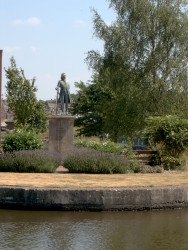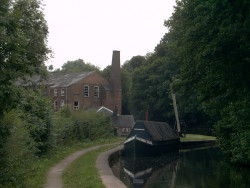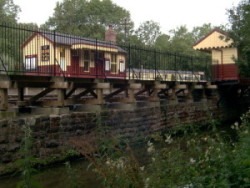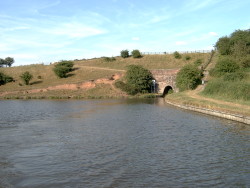The Caldon Canal – a great place for a narrowboat holiday
I’ve made little secret of the fact that the Caldon Canal is one of my personal favourites throughout the British canal network, and is a popular destination for those on a narrowboat holiday. The Caldon Canal (it’s a lot shorter than having to say its full name of the Caldon Branch of the Trent and Mersey Canal) was opened in 1779. It was originally built to bring limestone down from the quarries at Caldon Low – which lies a few miles away to the east – and starts its journey at Etruria Junction. If you have a little time, Etruria is an interesting place for the narrowboater to dwell. It is probably why a narrowboat hire company has made its base at Festival Park Marina, just a few hundred yards up from the junction.
The Etruria Industrial Museum (housed in the wonderfully named Etruscan Bone Mill) sits directly opposite a statue to James Brindley – who stares impassionedly towards Bedford Street locks – a huge paired staircase that lifts the canal an impressive 19’3”.

James Brindley at Etruria
A short journey onwards, and having negotiated Planet Lock, the narrowboater will pass through Hanley Park, which extends on both side of the canal. Keep your eyes open for some Bottle Kilns on this canal – they had been left up following the demolition of a factory, but looked as though they were being incorporated into a new housing estate.
I’d like to give a word of warning about some of the bridges on this early section of the canal. Some are very low – and I do mean VERY. Some narrowboaters may find that they have to take their chimneys down to pass under one of two road bridges that reduce the air draught dramatically, depending on which side of the canal you are.
There are a couple of lift bridges on this stretch of canal, and those on a narrowboat holiday will find the first at Ivy House. It used to require quite a hefty pull to get it to move and we had to enlist the help of a passer-by to act as additional ballast before the bridge started to lift. Fortunately the bridge is now electrically operated.
Passing through the village of Milton, there are some good deep moorings to be found before the pumping station at Lock 24. These are the start of the Stockton Brook Locks which lift the Caldon Canal another 41 feet to its summit level.
Shortly after the flight, boaters will encounter a rather unusual obstacle in the middle of the canal. A circular platform is all that remains of a light railway swing bridge pivot point. Having negotiated the platform, the canal turns sharply right, skirts the village of Endon and arrives at the beautifully situated Hazelhurst Junction. Taking the right hand branch, the canal branches off towards Leek, passing over an aqueduct with the main line and Deep Hayes Country Park far below. The branch parallels the Caldon Canal for a short while, albeit on two different contours before the two waterways head in different directions.
The Leek Branch continues on before opening into a broad lagoon and the 130 yard long Leek Tunnel. Whilst this is easy to see straight through, narrowboat crews should ensure they are lined up prior to entering the tunnel as it is very narrow. A winding hole appears shortly after and announces the end of the Leek Branch and the canal terminus.
Meanwhile…..taking the left branch at Hazelhurst Junction the canal drops almost 26 feet through the Hazelhurst Locks and enters the Churnet Valley. The canal is bounded by high ridges here, making the boaters journey all the more secretive, until it reaches the fascinating Flint Mill at Cheddleton. This is powered by a set of twin waterwheels, and there are an attractive collection of cottages that lie alongside the mill.

Cheddleton Flint Mill and nb Vienna
The canal side scene is made all the more evocative of a bygone age by the appearance of the preserved working boat ‘Vienna’ moored alongside, together with a loading crane.
As the boater moves further along the Caldon Canal, the scenery becomes even more sylvan with heavy woods coming right down to the water’s edge. Eventually, the Caldon Canal merges with the River Churnet at Oak Meadow Ford Lock, and the boater may notice that the water has become clearer with the rivers flow, and many reeds and plants can be seen.
Navigating a mile further, the canal opens out a little at Consall Forge. Here, a well know pub, the Black Lion, does a roaring trade from boaters and walkers alike, and its numbers swell when joined by passengers from the Churnet Valley Steam Railway.

Consall Station
The beautifully restored Consall Station has an unusual, cantilevered waiting room that extends over the canal, which drops through Flint Mill Lock, curves around the valley and passes under Cherry Eye Bridge. The unusual name of this bridge is said to come from the inflamed and bloodshot eyes of the workers in the Limestone quarries.
The canal is very narrow at this point – two boats cannot pass side by side, so caution is advised, Soon after, the canal reaches Froghall and its tunnel, which is often the end of the line as far as most narrowboat cruises go. Froghall Tunnel is extremely low – maximum height was only 4’9” above the waterline, so all but the lowest boat needed to wind and moor up, rather than head through. Changes to the cut have increased this by about 6″ but if your boat cannot get through, a short walk to the other side of the tunnel is worth it, as the true canal terminus appears, together with a fine wharf house and stables, some limekilns and a picnic area and shop.
So all in all, an eventful canal, with lift bridges, flint mills, lime kilns, tunnels and aqueducts, the Caldon Canal has something for everyone – all crammed into an arm that is 17 miles long (with the Leek Arm adding an additional and equally interesting 3 miles). It’s little wonder that it remains one of the most popular diversions from the more industrialised Trent and Mersey Canal.

